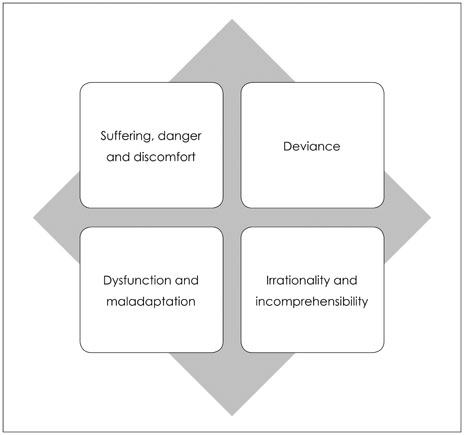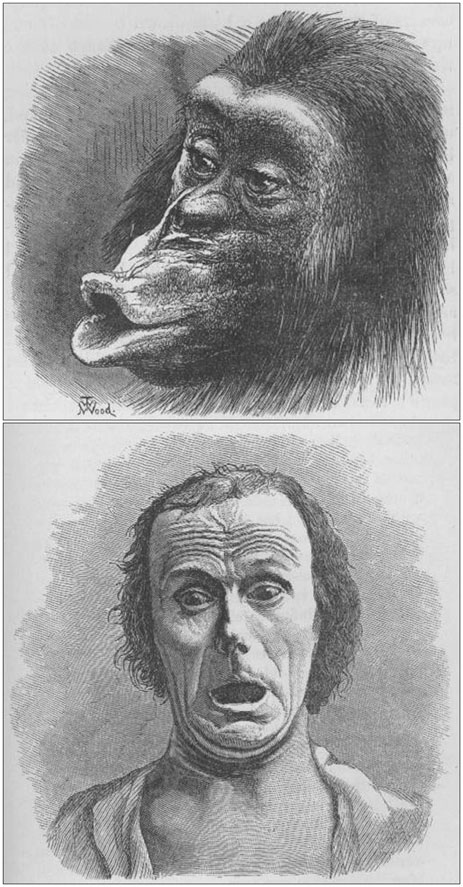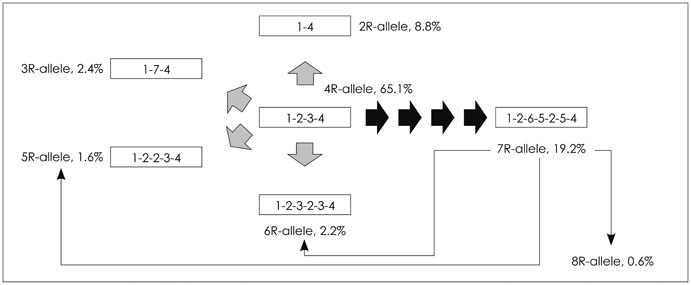J Korean Neuropsychiatr Assoc.
2014 Nov;53(6):347-357. 10.4306/jknpa.2014.53.6.347.
Evolutionary Approaches toward Psychiatry
- Affiliations
-
- 1Department of Psychiatry, St. Andrews Neuropsychiatric Hospital, Icheon, Korea. hansonpark@snu.ac.kr
- 2Department of Anthropology, College of Social Science, Seoul National University, Seoul, Korea.
- KMID: 2383323
- DOI: http://doi.org/10.4306/jknpa.2014.53.6.347
Abstract
- Evolutionary anthropology is the multidisciplinary field of social and natural sciences regarding the physiology and behavior of Homo Sapiens, and the relationship between human and other Hominoids like primates or ancient human species. Evolutionary anthropological approach toward psychiatry is a promising way to resolve the inter-disciplinary conflicts between different fields of study of the human mind. Evolutionary psychiatry is the specialized part of applied biologic anthropology and clinical psychiatry dealing with the biological causes of mental disorders, the impacts of cultural change toward the evolution of the human mind by studying the ancestry of mankind. I attempted to overview the history of evolutionary anthropology or neuroanthropology related to brain and mind, and the possibility of evolutionary psychiatry by showing the progress of academic and social issues regarding the ultimate causes of several mental illnesses.
Figure
Reference
-
1. Nesse RM. Evolution at 150: time for truly biological psychiatry. Br J Psychiatry. 2009; 195:471–472.
Article2. McGuire MT, Troisi A. Darwinian psychiatry. New York: Oxford University Press;1998.3. Nesse RM. Fear and fitness: an evolutionary analysis of anxiety disorders. Ethol Sociobiol. 1994; 15:247–261.
Article4. Nesse RM. An evolutionary perspective on psychiatry. Compr Psychiatry. 1984; 25:575–580.
Article5. Williams GC, Nesse RM. The dawn of Darwinian medicine. Q Rev Biol. 1991; 66:1–22.
Article6. Nesse RM. Why we get sick: The new science of Darwinian medicine. New York: Random House LLC;1996.7. Nesse RM. Evolutionary psychology and mental health. In : Buss DM, editor. The handbook of evolutionary psychology. Hoblken, NJ: John Wiley & Sons, Inc.;2005. p. 903–927.8. Panksepp J, Biven L. The archaeology of mind: neuroevolutionary origins of human emotions. New York: W. W. Norton & Co.;2012.9. Szacz T. Ideology and insaniiy. London: Penguin;1974.10. Comer RJ. Abnormal psychology. New York: Macmillan;2010.11. Cartwright J. Evolution and human behaviour: Darwinian perspectives on human nature. 2nd ed. New York: The MIT Press;2008.12. Kuhn TS. The structure of scientific revolutions. Chicago: University of Chicago press;2012.13. Van Parijs P. Evolutionary explanation in the social sciences: an emerging paradigm. New Jersey: Rowman & Littlefield;1981.14. Tabin CJ. Why we have (only) five fingers per hand: hox genes and the evolution of paired limbs. Development. 1992; 116:289–296.
Article15. Carroll SB. Endless forms most beautiful: the new science of evo devo and the making of the animal kingdom. New York: Norton;2005.16. Darwin C. The descent of man and selection in relation to sex: gryphon editions. Chicago: Encyclopedia Britannica, Inc.;1990.17. Darwin CR. Darwin F, editor. The expression of the emotions in man and animals. 2nd ed. London: John Murray;1890.18. Romanes GJ. The factors of organic evolution. Nature. 1887; 36:401–407.
Article19. Spencer H. The principles of psychology. New York: D. Appleton;1895.20. Dennett DC. Darwin's dangerous idea: evolution and the meanings of life. New York: Simon and Schuster;1996.21. Gould SJ. The mismeasure of man. New York: WW Norton & Company;1996.22. Nesse RM, Williams GC. Why we get sick: the new science of Darwinian medicine. New York: Times Books;1994.23. Nesse RM. Natural selection and the regulation of defenses: a signal detection analysis of the smoke detector principle. Evol Hum Behav. 2005; 26:88–105.24. Brüne M. Textbook of evolutionary psychiatry: the origins of psychopathology. New York: Oxford University Press;2008.25. Stevens A, Price J. Evolutionary psychiatry: a new beginning. London; Philadelphia: Routledge;2000.26. Boas F. The mind of primitive man: a course of lectures delivered before the Lowell institute, Boston, Mass., and the National university of Mexico, 1910-1911. New York: The Macmillan Company;1911.27. Durkheim E. The Elementary Forms of the Religious Life. New York: Collier Books;1961.28. McGee RJ. Anthropological theory: an introductory history. 5th ed. New York: McGraw-Hill;2012.29. Erickson PA, Murphy LD. Readings for A history of anthropological theory. Toronto; New York: University of Toronto Press;2010.30. Devereux G. Basic problems of ethnopsychiatry. Chicago: University of Chicago Press;1980.31. Foster GM, Anderson BG. Medical anthropology. New York: Wiley;1978.32. Gaines AD. Ethnopsychiatry: the cultural construction of professional and folk psychiatries. Albany: State University of New York Press;1992.33. American Psychiatric Association. Diagnostic and statistical manual of mental disorders: DSM-5. 5th ed. Washington, DC: American Psychiatric Association;2013.34. Smith CM, Davies ETS. Anthropology for dummies. Hoboken, NJ: Wiley; Chichester: John Wiley;2008.35. Stocking GW Jr. Delimiting anthropology: occasional essays and reflections. Madison: University of Wisconsin Press;2001.36. Ridley M. Nature via nurture: genes, experience and what makes us human. New York: HarperCollins Publishers;2003.37. Sparks CS, Jantz RL. Changing times, changing faces: Franz Boas's immigrant study in modern perspective. American Anthropologist. 2003; 105:333–337.
Article38. Chagnon NA. Evolutionary biology and human social behavior: an anthropological perspective. North Scituate, MA: Duxbury Press;1979.39. Domínguez Duque JF, Turner R, Lewis ED, Egan G. Neuroanthropology: a humanistic science for the study of the culture-brain nexus. Soc Cogn Affect Neurosci. 2010; 5:138–147.
Article40. McGill TE. Readings in animal behavior. New York: Holt, Rinehart and Winston;1965.41. Hinde RA. Ethology, its nature and relations with other sciences. New York: Oxford University Press;1982.42. Stevens A, Price J. Evolutionary psychiatry: a new beginning. London: Routledge;1996.43. Premack D, Woodruff G. Does the chimpanzee have a theory of mind? Behav Brain Sci. 1978; 1:515–526.
Article44. Baron-Cohen S. Mindblindness: an essay on autism and theory of mind. Cambridge, MA: The MIT Press;1997.45. Baron-Cohen S. The maladapted mind: classic readings in evolutionary psychopathology. Hove: Psychology Press;1997.46. Dunbar RIM. Coevolution of neocortical size, group size and language in humans. Behav Brain Sci. 1993; 16:681–694.
Article47. Gabbard GO. Psychodynamic psychiatry in clinical practice. Washington, DC: American Psychiatric Publishing;2014.48. Smith DC. The limits of biological psychiatry. J Am Acad Psychoanal. 1999; 27:671–680.49. Gluckman PD, Beedle A, Hanson MA. Principles of evolutionary medicine. Oxford: Oxford University Press;2009.50. Boyd R, Silk JB. How humans evolved. New York: W.W. Norton & Co.;2012.51. Futuyma DJ. Evolution. 3rd ed. Sunderland, MA: Sinauer Associates, Inc. Publishers;2013.52. Ding YC, Chi HC, Grady DL, Morishima A, Kidd JR, Kidd KK, et al. Evidence of positive selection acting at the human dopamine receptor D4 gene locus. Proc Natl Acad Sci U S A. 2002; 99:309–314.
Article53. Ebstein RP, Novick O, Umansky R, Priel B, Osher Y, Blaine D, et al. Dopamine D4 receptor (D4DR) exon III polymorphism associated with the human personality trait of Novelty Seeking. Nat Genet. 1996; 12:78–80.
Article54. Goldner EM, Hsu L, Waraich P, Somers JM. Prevalence and incidence studies of schizophrenic disorders: a systematic review of the literature. Can J Psychiatry. 2002; 47:833–843.
Article55. Torrey EF. Prevalence studies in schizophrenia. Br J Psychiatry. 1987; 150:598–608.
Article56. Bassuk EL, Gerson S. Deinstitutionalization and mental health services. Sci Am. 1978; 238:46–53.
Article57. Caudill WA. The psychiatric hospital as a small society. Cambridge, MA: Pub. for the Commonwealth Fund by Harvard Univ. Press;1958.58. Swallow SR. A cognitive behavioural perspective on the involuntary defeat strategy. In : Sloman L, Gilbert P, editors. Subordination and defeat: an evolutionary approach to mood disorders and their therapy. Mahwah, NJ: Lawrence Erlbaum;2000. p. 181–198.59. Sloman L, Gilbert P, Hasey G. Evolved mechanisms in depression: the role and interaction of attachment and social rank in depression. J Affect Disord. 2003; 74:107–121.
Article60. Sloman L, Gilbert P. Subordination and defeat: an evolutionary approach to mood disorders and their therapy. Mahwah, NJ: Lawrence Erlbaum;2000.61. Bateson G. Steps to an ecology of mind: collected essays in anthropology, psychiatry, evolution, and epistemology. Chicago: University of Chicago Press;1972.62. Holloway RL, Sherwood CC, Hof PR, Rilling JK. Evolution of the brain in humans-Paleoneurology. In : Binder MD, Hirokawa N, Windhorst Windhorst U, editors. Encyclopedia of neuroscience. Berlin: Springer Berlin Heidelberg;2009. p. 1326–1338.63. Holloway RL, Broadfield DC, Yuan MS. The human fossil record: vol. 3, brain endocasts -- the paleoneurological evidence. New York: Wiley-Liss;2004.64. Lock A, Peters CR. Handbook of human symbolic evolution. Oxford: Oxford University Press;1996.65. Jerison HJ. Evolution of the brain and intelligence. New York: Academic Press;1973.66. Eccles JC. Evolution of the brain: creation of the self. London; New York: Routledge;1991.67. Polimeni J. Shamans among us: schizophrenia, shamanism and the evolutionary origins of religion. Raleigh: Lulu Com;2013.68. Ghaemi SN. The concepts of psychiatry: a pluralistic approach to the mind and mental illness. Baltimore, MD: The Johns Hopkins University Press;2004.69. Stein DJ, Lund C, Nesse RM. Classification systems in psychiatry: diagnosis and global mental health in the era of DSM-5 and ICD-11. Curr Opin Psychiatry. 2013; 26:493–497.70. Blacher J, Christensen L. Sowing the seeds of the autism field: Leo Kanner (1943). Intellect Dev Disabil. 2011; 49:172–191.
Article71. Wilson DS, Dietrich E, Clark AB. On the inappropriate use of the naturalistic fallacy in evolutionary psychology. Biol Philos. 2003; 18:669–681.
Article72. Dobzhansky T. Nothing in biology makes sense except in the light of evolution. American Biology Teacher. 1973; 35:125–129.
Article73. Panksepp J. Emotional endophenotypes in evolutionary psychiatry. Prog Neuropsychopharmacol Biol Psychiatry. 2006; 30:774–784.
Article
- Full Text Links
- Actions
-
Cited
- CITED
-
- Close
- Share
- Similar articles
-
- Research Methodologies of Evolutionary Psychiatry
- Evolutionary Psychiatry I-Concept of Evolutionary Psychology and Evolutionary Psychopathology
- The Evolutionary Psychological Aspects of Anxiety and Anxiety Disorders
- Evolutionary Psychiatry II-Mental Functions and Diseases from the Evolutionary Perspective
- Evolutionary Hypotheses of Mental Disorder and Their Limitations




